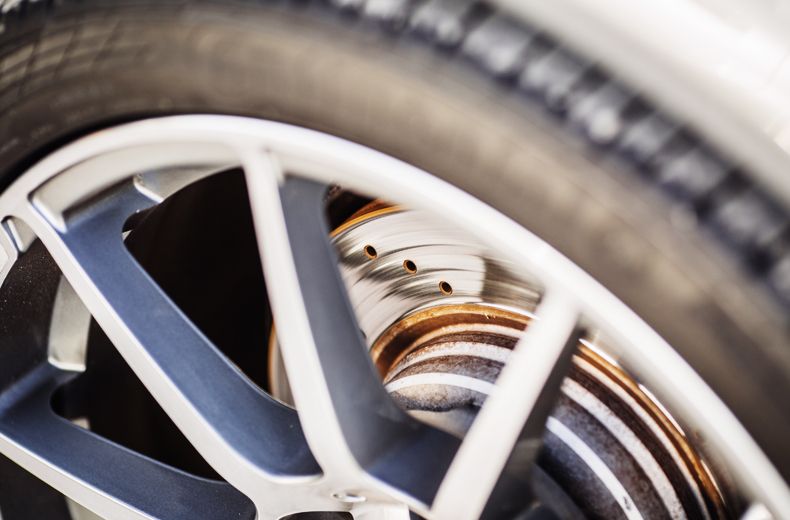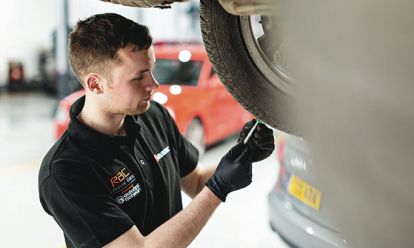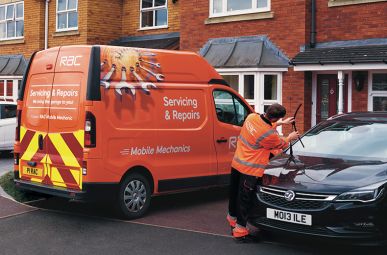Here we run through the different types of brake pad, how to make them last longer, how to replace them yourself and much more.
Brake pads
A typical vehicle braking system consists of a pair of brake pads, a brake disc and a brake calliper for each wheel.
The pads are fitted in the calliper with their friction material almost touching the two sides of the brake disc.
When the brake pedal is pressed, hydraulic fluid in the calliper pushes each brake pad against each side of the rotating brake disc. This results in friction which slows down and eventually stops the vehicle.
When you think of the number of times this simple action takes place every day, week, month and year – it's no surprise that brake pads suffer gradual wear, so they need replacing regularly.
How long do brake pads last?
There are no hard and fast rules on this. A set of brake pads can last from anywhere between 30,000 and 70,000 miles – possibly more.
A major factor in the lifespan of the pads is down to the way the vehicle is driven.
What factors can affect how long your brake pads last?
It's worth taking into account the following factors to give you an idea of how long your brake pads might last.
Where and how you drive
If a lot of your driving is done on the motorway, you might find your brake pads last longer than if you drive more around inner cities and on shorter journeys.
That’s because urban journeys require more stopping and starting at traffic lights, roundabouts and junctions – so your brakes are used far more often than when cruising along on a motorway.
Your driving style also plays a part. Those that don't brake unnecessarily and apply the brakes gently well in advance of needing to stop should find their brake pads wear slower than those that brake aggressively at the last minute and constantly speed up and slow down.
The weight of your car
Another factor in brake pad wear is the weight regularly being carried by the vehicle, e.g. four or five passengers, fully loaded boot, towing a caravan etc. When the vehicle is lighter it’s easier to slow down and stop with less braking effort required.
A vehicle used by a 5-person family is obviously heavier than say, one used by a couple – so stopping it in the same amount of time requires greater pressure and puts more strain on brake pads.
Type of brake pads
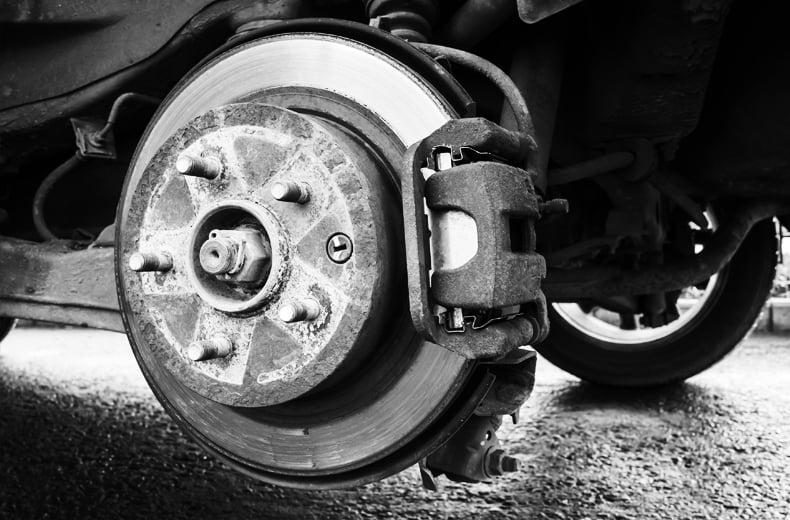
The type of pads you can have in your vehicle also vary in durability:
- Organic brake pads are generally the cheapest but have a shorter life span
- Low metallic brake pads can be noisy, but have a slightly longer life expectancy than organic
- Semi-metallic or sintered brake pads use fused metal particles such as copper and bronze along with other materials. Although they offer excellent braking performance and have a long life expectancy they may wear brake discs down quicker than other pads
- Ceramic brake pads last longer than other materials and are more resistant to wear. The drawback is that these are also more expensive than others
How many miles you cover
Although it fluctuates based on the type of road you’re on: the more miles you put in, the more you use your brakes and the faster your brake pads wear out. It's as simple as that.
Usually, front brake pads will wear out faster than those at the rear because the front handles more of the braking load.
When to replace brake pads
Never ignore brake pads that need replacing. Most vehicles are fitted with wear sensors to detect when front or rear brake pads are getting critically low. However, there are other signs to look out for too.
Warning light
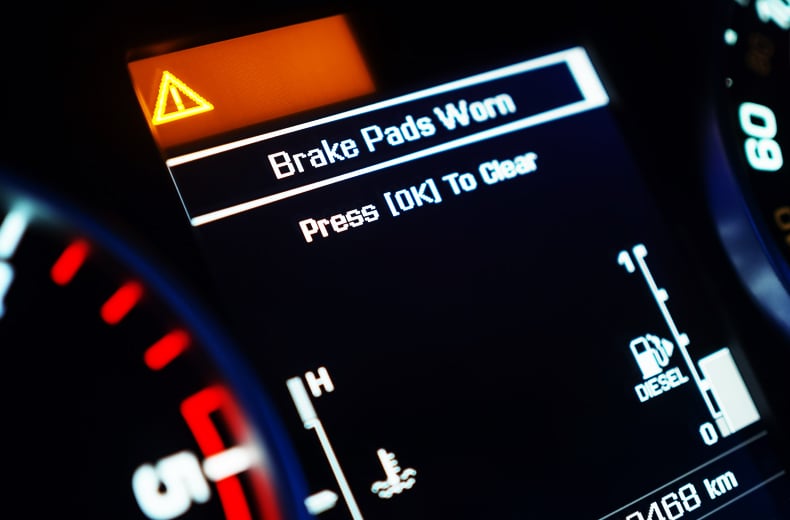
The most obvious indication is a brake pad wear warning light such as the one above.
It will show on the car's display board to indicate that at least one set of pads is almost worn out and a replacement needs to be fitted.
However, not all cars are equipped with brake pad sensors. If your car doesn't have them, you must make sure the pads are inspected and checked by a professional regularly.
Services will assess the condition of brake pads but at other times, listen and look for the possible flaws mentioned below.
Find a reliable local garage with our search tool.
Loud screeching
If you can hear a loud screeching sound when braking it's a real warning sign that new brake pads are needed, or at least the current ones require inspection.
If you hear a grinding noise, it's likely the brake pads have been worn down completely. If this happens you should not drive the vehicle and arrange for the brakes to be checked and replaced as soon as possible.
- Why is my car making that noise? A guide to unusual vehicle noises
- The ultimate guide to car parts and what they do
- MOT checklist and comprehensive guide
Visual check
It's sometimes possible to look at the brake pads for wear and tear.
Depending on the vehicle model, you may be able to see the outer pad by looking through the spokes of the wheel – the outer pad will be pressed against the brake disc.
There should be at least 3mm of pad visible. If you see anything less, get the brake pads inspected.
This is the kind of check you should be getting during a car service, but be aware that some unscrupulous garages might be skipping the removal of your wheel to check, so use a garage you trust, or use a RAC Mobile Mechanic.
Pulling to one side
While braking, if the vehicle feels as if it pulls to one side, then it's likely that a brake fault exists.
Uneven pad wear will be caused by an imbalance in braking efficiency, which needs to be checked and rectified.
How to make brake pads last longer
There are ways of making brake pads last longer:
- Be aware of traffic and anticipate potential braking situations – apply brakes steadily and gradually instead of suddenly slamming them on
- Avoid high-speed driving – sudden braking puts brake pads under extra pressure
- Accelerate gently as heavy, sudden braking increases wear and tear – driving responsibly can reduce damage and contribute to a longer life span
- Drive light – you can’t always avoid having passengers, but you can unload anything in the vehicle that isn't required for a particular journey. Clear out the boot, remove an unused roof rack, that kind of thing
Book a car service today
It’s easy to book a service online at one of our local approved garages. Find a trusted local garage with the RAC stamp of approval.
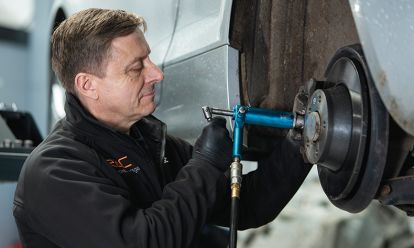

Can I replace my own brake pads?
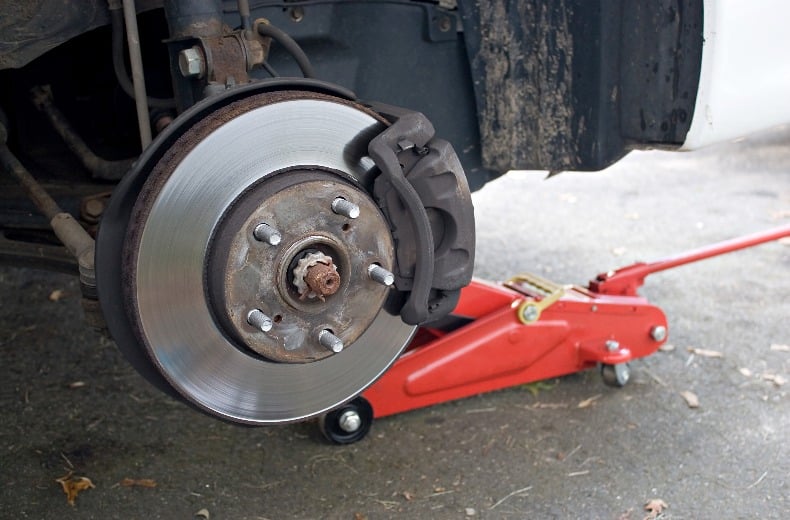
Replacing brake pads yourself requires a good level of mechanical knowledge – it's not like checking tyre pressure or topping up oil levels. Even jacking the car up is fraught with hazards if not done safely and correctly.
Pads not correctly seated, callipers not fully secured, brake hoses working loose - all of these can leave you in serious danger. We'd always advise leaving it to a mechanic or garage if you're not absolutely sure what you're doing.
This is work that must be carried out by someone who is competent and confident – remember that brake pads are a critical part which, if fitted incorrectly, could lead to brake failure and severe consequences.
Step-by-step guide
You should change brake pads in sets, for example front wheels together and back wheels together. Follow these steps to replace your brake pads:
- remove your wheel – use a jack to safely lift your car on a level surface, you'll also want to use axle stands for extra safety
- remove the guide pin bolt – use a spanner to hold the guide pin, and unscrew and remove the bolt
- remove brake pads – unbolt the callipers before removing the clips, holding the brake pads and their mounting brackets
- inspect the brake disc – make sure you check the brake disc for damage too
- tighten the clamp – allow pressure in the system to escape by removing the top from the brake fluid reservoir – watch for overflowing liquid as you tighten the clamp
- apply lubricant – add copper grease to the edges and backs of the new brake pads while avoiding contact with the friction linings
- fit brake pads – fit the new pads into the mounting bracket, the callipers should slip over the new, thicker pads once they’re put back into place. Then refit and secure the calliper
- test them out – once you’ve fitted the new pads press on the brake pedal a few times to check that they make contact with the disc. You may need to top-up your brake fluid too
If you're unsure about the efficiency or performance of your brakes, or think they may need replacing, why not make an appointment at an RAC Approved Garage near you?

Roadside & Recovery from £5.29 a month*
• Cheaper than AA Price Guarantee^
• We get to most breakdowns in 60 mins or less
• Our patrols fix 4/5 breakdowns on the spot

How long do brake discs last?
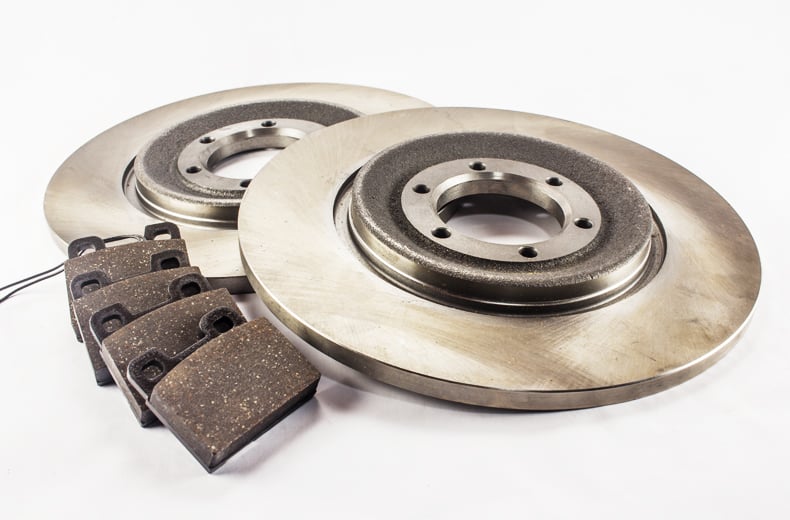
As with brake pads, life expectancy of brake discs will differ from vehicle to vehicle.
Sometimes, both pads and discs will need changing and replacing at the same time, though generally discs will outlast pads.
Front brake discs will eventually get too thin, which could result in overheating and loss of efficiency. The required thickness of a brake disc is dictated by the manufacturer.
How can I tell if my brake discs need replacing?
Although you should aim to replace brake discs along with brake pads, you can keep an eye or ear out for the following signs:
- a warning light should illuminate when there is a problem somewhere in the braking system
- a loud screeching can occur as a result of rust build-up on the discs, however the damage should wear off after driving
- bad vibrations could indicate warped discs that the naked eye may struggle to recognise
- longer braking times can indicate wear and tear to the disc and pads
- grinding sounds are usually made when your pads become worn, the damaged parts will accelerate wear and tear to brake discs
Car playing up?
Get quality repairs at a fair price, plus a 12 month warranty with RAC Approved Garages.


How do I choose new brake pads?
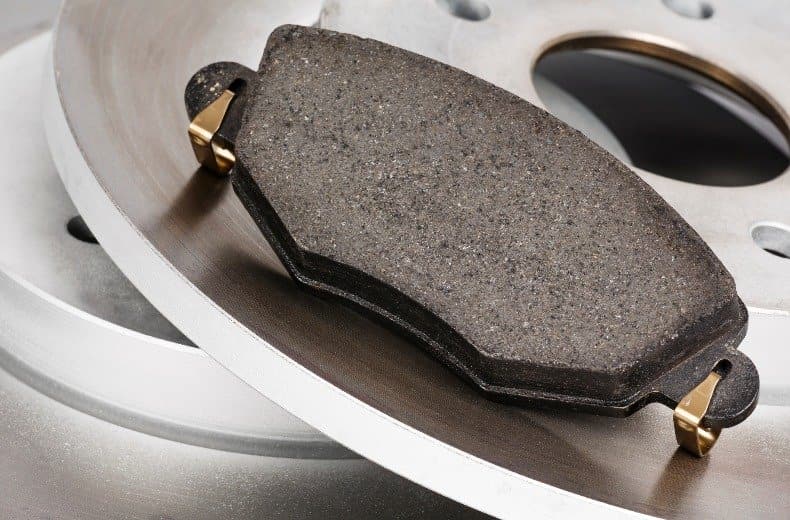
Your ideal brake pads will depend on your driving style and the conditions that you keep and drive your car in. You’ll need to consider the following:
Material
Organic brakes are perfectly suitable for smaller cars and a great option if you’re looking for something eco-friendly and easy on your discs, however, their shorter lifespan may not suit your needs.
Larger, more powerful car owners may want to fit metallic pads for their improved stopping power but should be aware that they’re usually louder than other materials.
Ceramic brakes are perfect for high-performance, long-lasting and near-silent braking, but come with an expensive price tag.
Operating temperature
Most drivers won’t have to worry about the temperature of their brakes, especially those that avoid heavy or sudden braking.
However, if you enjoy taking your car on a track day, or know that you tend to brake late, you may want to consider pads designed to withstand higher temperatures.
Ease of installation
If you’re planning on fitting brake pads yourself you’ll want to check how difficult the job could be. Some manufacturers include the bare essentials with their pads, while others add extras to avoid having to find and buy additional hardware.
Noise level
Although damaged brake pads often give off a screeching sound, perfectly good pads can also be noisy. Metallic pads tend to be the loudest, followed by organic pads.
If the sound of braking really grates on you, ceramic pads are a near-silent option.
Brake dust
If you want to avoid cleaning brake dust from your wheels, ceramic pads are your best option. However, they can prove expensive and you may want to go for organic brake pads that give off slightly more debris.
Cost
It may be tempting to buy cheaper parts to save on costs, however, the budget option may end up more expensive over time. Look out for quality pads that offer more value for money by avoiding the need to buy and fit replacements.
- Car battery conditioners and trickle chargers – everything you need to know
- 12 simple car maintenance checks you should definitely be doing
- Car dashboard symbols and meanings – warning lights guide
Are brake pads checked as part of an MOT test?
As they make up part of the most important safety feature of our cars, the braking system is thoroughly checked during an MOT test. This includes brake pads, brake discs, and callipers.
Brake pads with a thickness of 3 millimetres or under should be replaced.
Need your brakes repaired?
RAC Mobile Mechanics offer maximum convenience and can replace your brakes on your doorstep.


How can I measure brake pad thickness?
There are a number of methods for checking your brake pad thickness with your wheel attached to the car, but the most accurate way will involve removing your tyre. You should:
- remove your wheel – use a jack to safely lift your car on a level surface, you may want to use axle stands for extra safety
- inspect the brake pads – they should be visible through the edge of the calliper and easily measured
- reinstall the wheels – fix them back in position, making sure you tighten lug nuts before lowering the jack
If you do need a brake pad repair, you can use our RAC Approved Garage network or RAC Mobile Mechanics.
If your MOT is due or if you would like to book your vehicle in for a full car service, you can book online with your local RAC Approved Garage today.
Make sure you have RAC breakdown cover, van breakdown cover or business breakdown cover too!
How much does it cost to replace brake pads? Find out here.
Need your brakes repaired? Get them done by an RAC Mobile Mechanic.
Need your brakes repaired?
RAC Mobile Mechanics offer maximum convenience and can replace your brakes on your doorstep.


FAQs
- How much does it cost to replace brake pads?
The price of replacing your brake pads will depend on your location, the pads you go for and your car. It’s also recommended to change your brake discs while replacing your brake pads.
Generally speaking you can expect to pay anything between £100 to £300.
- How can I tell if my brake pads are worn?
If your brake pads are worn you may experience screeching while braking, heavy vibrating or your car pulling to one side as you press down on the brake pedal.
You may also find it takes longer than usual for your brakes to slow your car down. A warning light will also help flag any problems with wear and tear.
- How long will 1mm of brake pad last?
The lifespan of any brake pad will depend on the material it’s made from, your driving habits, and the elements it’s exposed to. With so many factors at play it’s difficult to say how long 1mm or 3mm of brake pads will last.
- What does a worn brake pad sound like?
Brake pads are designed to give off a noise when worn down and the most common sound to listen out for is a high-pitched screech, audible through most car windows. The same noise can occur as a result of rust build-up but should quieten down after a short period of driving.
Completely worn brake pads will produce a metallic grinding noise and the problem should be addressed immediately.
- Can you check brake pads without removing the wheel?
It’s possible to check your brake pads without removing the wheel but your measurements will probably be inaccurate. Restricted access to brake pads and factoring in the thickness of the backing plate can skew results.
For a reliable reading it’s best to completely remove the wheel.
- How many miles do brake pads last?
The lifespan of your brake pads depends on a number of factors but guidelines for manufacturers suggest they should last between 30,000 to 70,000 miles.
- Should I replace all brake pads at once?
Brake pads on the front wheels of the car will wear down quicker as they take on more of the braking load than your rear tyres. This means that it’s not essential to change four brake pads at once, but you should always change both front and both rear pads together.
- Why are my brake pads wearing down so quickly?
If you find that your brake pads are wearing down quickly, the problem could be:
- the brake pads – are they faulty? Are they suitable for your car? Make sure you choose your next set of brake pads to best suit your needs.
- your driving – are you prone to sudden braking? Perhaps you take your car on track days and could use a different vehicle? Small changes to your driving habits for a smoother ride will improve the lifespan of your brake pads.
Services we offer
- Breakdown Cover
- European Breakdown Cover
- Motorbike Breakdown Cover
- Electric Car Breakdown Cover
- Caravan, Motorhome and Campervan Breakdown Cover
- Business Breakdown Cover
- Van Breakdown Cover
- RAC Approved Garages
- Vehicle servicing
- Vehicle repair
- MOTs
- Mobile mechanics
- RAC Tyres
- RAC Approved Dealers
- RAC Shop
- myRAC app

Roadside & Recovery from £5.29 a month*
• Cheaper than AA Price Guarantee^
• We get to most breakdowns in 60 mins or less
• Our patrols fix 4/5 breakdowns on the spot


